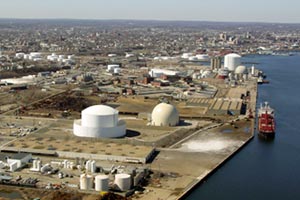Rhode Island Voters to Decide on Spending $20 Million for Port Upgrades

PROVIDENCE, R.I. — Bananas, pineapples and pears — thousands of them — stream across the docks on their way to supermarkets throughout the Northeast.
A crane unloads a shipping container of merchandise bound for CVS stores.
Used Toyotas hop a freighter for West Africa.
These are examples of the long-term vision, maybe decades away, that city and state officials have for a half-mile stretch of the Allens Avenue waterfront best known in recent years for strip clubs, zoning fights and failed redevelopment plans.
"A very small scrap operation and a series of dirt patches" is how Bill Fischer, spokesman for ProvPort Inc., described the land his organization hopes to transform.
But first, Rhode Island voters would need to endorse the state's vision in November by approving the $20 million purchase of up to 25 acres of property of Allens Avenue waterfront to expand the city’s port.
"Baby steps" are what Chris Waterson, general manager of Waterson Terminal Services, calls the first phase of expanding the port his company operates.
Looked at another way, city and state leaders want ProvPort to do for Allens Avenue what Quonset Development Corp. is doing for the abandoned former Quonset Point Navy base in North Kingstown: turn underutilized land into a trade and employment hub.
"ProvPort is not a household name in Rhode Island," Fischer said. "But this has been a very successful economic generator for the state, and we want to continue on that success. If we want to grow, it is not going to happen without additional land."
Some 1,700 people work at ProvPort, and the organization predicts the expansion would add 300 jobs.
Not coincidentally, ProvPort has hitched its state-backed expansion plan to an even larger proposed state investment in Quonset, where officials are asking for a $50 million state bond to repair piers at the Port of Davisville. The two bonds will appear as a package and pass or fail together on the upcoming ballot.
Not everyone is convinced ProvPort should stretch down Allens Avenue.
"Moronic," Allens Avenue property owner Patrick Conley calls the idea of expanding ProvPort south of Thurbers Avenue. "To bring an industrial waterfront so close to the city and hospital district, where there might be questions of air pollution and toxins emanating from industrial activity, is foolish."
Conley's own plans to redevelop part of the area as a commercial and entertainment center were foiled years ago by the Providence City Council's insistence that Allens Avenue remain purely industrial.
But even previous supporters of a mixed-use waterfront, such as Council President Luis Aponte, are getting behind a ProvPort expansion.
"I think a reasonable person could say the [current] activity down there is not the highest and best use on the Providence waterfront," said Aponte, who along with Mayor Jorge Elorza worked on the expansion plan. "This proposal allows us to attract businesses that are not currently in the state ... and will provide jobs and an investment in this corridor."
ProvPort leases land to nine tenants, whose businesses include cement, auto exports, chlorine manufacturing, salt, scrap metal and petroleum.
In 2015, the port handled 1.3 million tons of cargo. The top commodity passing through the port was salt, followed by scrap metal, cement, coal and caustic soda (an ingredient in chlorine).
Of the $7.42 million in gross revenue ProvPort generated in 2015, a little more than half of it, $3.46 million, came from lease payments, while $3.43 million came from fees for security, dockage and use of the wharf. Waterson paid $519,000 to ProvPort for use of the new federally funded harbor crane.
Then there is the long-term vision that, outlined in a report by consultants Vickerman & Associates, would encompass up to 60 acres and involve three new vessel berths along Allens Avenue.
That vision looks to take advantage of a long-theorized expansion in the East Coast shipping market driven by the June 26 opening of an expanded Panama Canal.
Port officials expect the arrival of a new group of larger ships at the biggest East Coast ports to force smaller ships out to smaller ports, such as Providence.
Of particular interest to ProvPort, and highlighted by the Vickerman study, is the opportunity to import perishable foods to Providence, such as fresh fruit, if the port develops cold-storage warehouses.
Rhode Island is only one state scrambling to get a piece of this potential market.
Massachusetts has committed $600 million to port improvement, including the $113 million spent to build New Bedford's Marine Commerce Terminal. Connecticut is investing $700 million over several years to improve ports at Bridgeport, New London and New Haven.

